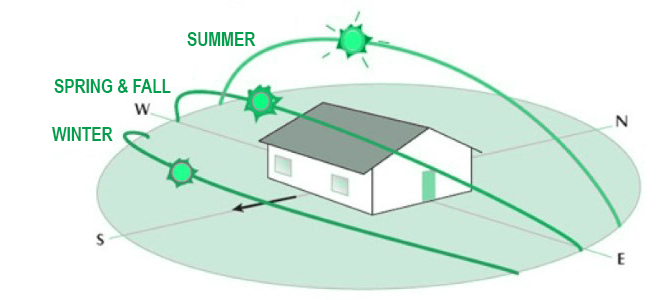What Direction Should Your Panels Face?
More and more people are turning to solar power in these uncertain times. Apart from decreasing or outright eliminating electric bills and the environmental benefits of a clean and renewable source of energy, many homeowners want the security of knowing they’re not dependent on the power grid for their essential electricity needs that going solar brings.
However, is every home amenable to a solar system? In particular, what direction does your roof need to face?Well, whether you live in Pennsylvania, California or anywhere else in the US, there’s only one answer to that question: south.
But if your roof doesn’t face directly south, don’t despair. Fortunately, there’s a fair bit of leeway here.
The Arc of The Sun

If you’re looking to have solar panels mounted on a roof anywhere in the northern hemisphere, ideally it ought to be facing south for the same reason “southern exposure” is considered a perk, you’ll get more sun.
Though during the summer the sun rises and sets slightly to the north, its east-to-west arc alway places it to the south when it’s higher in the sky and shining most brightly. Moreover, in winter months, the sun’s arc moves much further south, meaning it’s providing less solar energy and, hence, making it even more crucial that your panels get at least some southern exposure.
What If Your Roof Doesn’t Face South?
But obviously not every home comes with a roof that faces directly south. So, what happens if yours doesn’t? Is solar power still feasible?
20 years ago, you might have been out of luck. But thankfully, solar panels have become vastly more efficient in the last couple of decades and most homes with roofs that tilt to the south-east or south-west are able to generate significant amounts of power with a few additional panels.
But going solar isn’t out of the question even if your roof faces only directly north. Though it won’t get enough sun to make it a feasible surface for solar panels, if you have some unobstructed space, you can generate a lot of power with a ground-mounted system.
Ground-mounts

Since roof-mounted systems are by far the most popular, a lot of people just implicitly assume a roof is the only place solar panels can go. But thanks to the incredible increases in efficiency over the last couple of decades, it doesn’t take nearly as much space to generate a significant amount of power. So, if your house is on a bit of land, it’s very possible a ground-mounted system will work for you even if your roof won’t.
And, though roof-mounted systems have the obvious advantage of not taking up any space, ground-mounts also have a number of advantages of their own, including:
- COST: Because there's no need for technicians to affix them to your roof, ground installations involve significantly less labor costs.
- EFFICIENCY: Since their tilt and direction are in no way dependent on the structure of your home, there's no difficulty at all in setting up a ground-mounted system to get maximum sun exposure so each panel is generating power at its maximum capacity.
- AESTHETICS: Beauty of course, is in the eye of the beholder. And tastes vary considerably here. But some homeowners prefer ground-mounts because they want a pristine panel-free roof.
What’s Right For You?
Whether it’s on the up on the roof or down on the ground, determining how much energy a solar system will wind up giving you requires an extraordinary amount of very complex math.
The tilt and direction of each panel must be plugged into equations describing the suns ever-changing arc throughout the year. Local whether conditions and the effect of trees or any other objects that obstruct the sun at any point in its yearly arc also need to be rendered mathematically and factored in.
Fortunately, solar panels aren’t the only technology that has seen amazing improvement. Computers now have vastly more computational power. Though it’s for all intents and purposes impossible for any human to calculate how much energy a roof or ground-mounted system would generate annually, nowadays, using the latest software and satellite imagery, our trained technicians can do it without even leaving their desks.
So, if you’re looking for energy independence, give us a call. We can tell you how much monthly power you can expect to get from a roof or ground-mounted system, taking the guess-work out of your decision and making it matter of simple, straightforward, and easily-comprehended numbers.